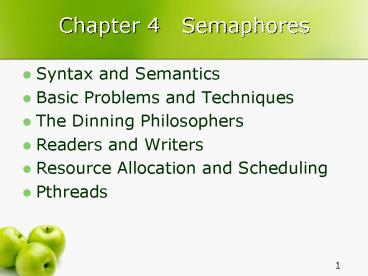Chapter 4 Semaphores - PowerPoint PPT Presentation
1 / 30
Title:
Chapter 4 Semaphores
Description:
A delayed reader is awakened only if no writer is waiting. ... Using Semaphores. 27. Generalizing the Problem. If we have more than one unit resources. ... – PowerPoint PPT presentation
Number of Views:103
Avg rating:3.0/5.0
Title: Chapter 4 Semaphores
1
Chapter 4 Semaphores
- Syntax and Semantics
- Basic Problems and Techniques
- The Dinning Philosophers
- Readers and Writers
- Resource Allocation and Scheduling
- Pthreads
2
Syntax and Semantics
- A Semaphore is a special kind of shared variable
that is manipulated only by two atomic
operations, P and V. - The value of a semaphore is a nonnegative
integer. - P(s) ltawait (sgt0) ss-1gt
- V(s) ltss1gt
- A general semaphore is one that can take on any
nonnegative value. - A binary semaphore is one whose value is always
either 0 or 1.
3
Critical Sections Mutual Exclusion
4
Barriers Signaling Events
5
Producers and Consumers Split Binary Semaphores
- Empty and full are together called a split binary
semaphore because at most one of these two can be
1 at a time.
6
Bounded Buffers Resource Counting
- Put items in the rear and fetch items in the
front of the array. - Bufrear data rear(rear1) n
- Results buffront front(front1)n
7
Single Producer / Consumer
- How about if there are two or more producers and
consumers?
8
Multiple Producers / Consumers
- Enforce mutual exclusion!!
9
The Dining Philosophers
- Five philosophers thinking or eating. Has to get
two forks to eat. Interesting but not hygiene.
10
The Dining Philosophers (cntd)
- Process Philosophers i0 to 4
- while(true)
- think
- acquire forks
- eat
- release forks
- Have to avoid deadlocks. A necessary condition
there is a circular waiting.
11
The Dining Philosophers (cntd)
12
The Readers / Writers Problem
- Two kinds of processes readers and writers
share a database. - Readers wait until no writers are inside.
- Writers wait until no readers or other writers
are accessing. - Mutual exclusion solution
- Condition synchronization solution
- Passing the baton.
13
An Exclusion Problem
14
An Exclusion Problem (cntd)
15
Exclusion Using Semaphores
- Readers preference. If some readers are
accessing the DB, both another reader and a
writer arrive, the new reader get preference over
the writer.
16
Using Condition Synchronization
17
Passing the Baton
- A process within the CS holding a baton passes it
to another process.
18
Passing the Baton (cntd)
19
Passing the Baton (cntd)
- Simplifying the SIGNAL statement
20
Alternative Scheduling Policies
- Last slide still gives readers preference.
- To give writers preference
- New readers are delayed if a writer is waiting
and, - Changing the readers first statement
- If (nwgt0 or dwgt0) drdr1 V(e) P(r)
- A delayed reader is awakened only if no writer is
waiting. - Switching the order of the first two arms of the
if statement in writers - If (dw gt 0) dwdw-1 V(w)
- Else if (drgt0) drdr-1 V(r)
- Else V(e)
21
Fair Access
- Delay a new reader when a writer is waiting
- Delay a new writer when a reader is waiting
- Awaken one waiting writer (if any) when a reader
finishes - Awaken all waiting readers (if any) when a writer
finishes other wise awaken one waiting writer
(if any).
22
Resource Allocation and Scheduling
- Multiple processes are competing some shared
resource. Decide who acquires the resource. - Request (parameters)
- ltawait (request can be satisified)
- take units
- Release (parameters)
- ltreturn unitsgt
23
Using the Passing-the-Baton
- Request (parameters)
- P(e)
- if (request cannot be satisfied) DELAY
- take units
- SIGNAL
- Release(parameters)
- P(e)
- return units
- SIGNAL
24
Shortest-Job-Next Allocation
- Requesting by calling request (time, id), where
time is an integer that specifies how long the
process will use the resource and id is an
integer that identifies the requesting process. - A process can be delayed forever if there is a
continual stream of requests specifying shorter
usage times. - Small modification a process that has been
delayed a long time is given preference, called
aging technique.
25
Implementation using Passing the Baton Technique
- Request (time, id)
- P(e)
- If(!free) DELAY
- Free false
- SIGNAL
- Release()
- P(e)
- Freetrue
- SIGNAL
26
Using Semaphores
27
Generalizing the Problem
- If we have more than one unit resources.
- Replace free by an integer avail that records the
number of available units. - In request(), test if amount lt avail,
- If so, allocate amount units.
- Otherwise, record how many units are required
before delaying - In release(), increase avail by amount.
- See page 184 for details.
28
Pthread
- POSIX Portable Operating Systems Interface.
POSIX thread. - Having the Fork-Join pattern.
- To use it
- include ltpthread.hgt
- Initialize the attributes
- pthread_attr_init(tattr)
- Pthread_attr_setscope(tattr, PTHREAD_SCOPE_SYSTEM
) - Pthread_create()
- Pthread_exit()
- Pthread_join(tid, value_ptr)
29
Semaphores
- Sem_t mutex
- Sem_init (mutex, SHARED, 1)
- Sem_wait (mutex) // P(mutex)
- Critical section
- Sem_post (mutex) // V(mutex)
30
Producer and Consumer (one buffer) using Pthreads































